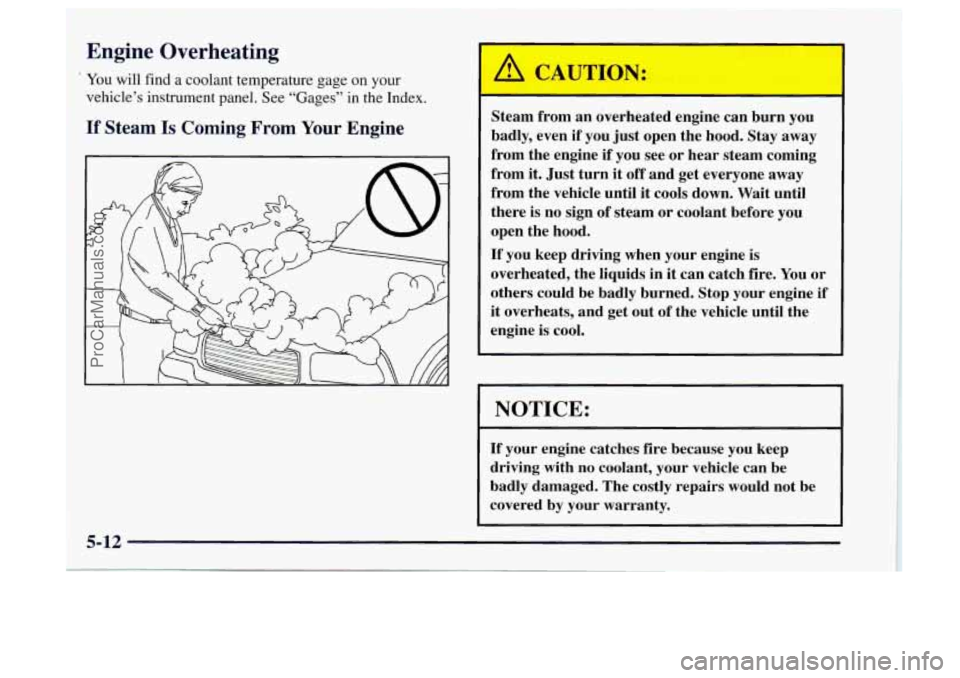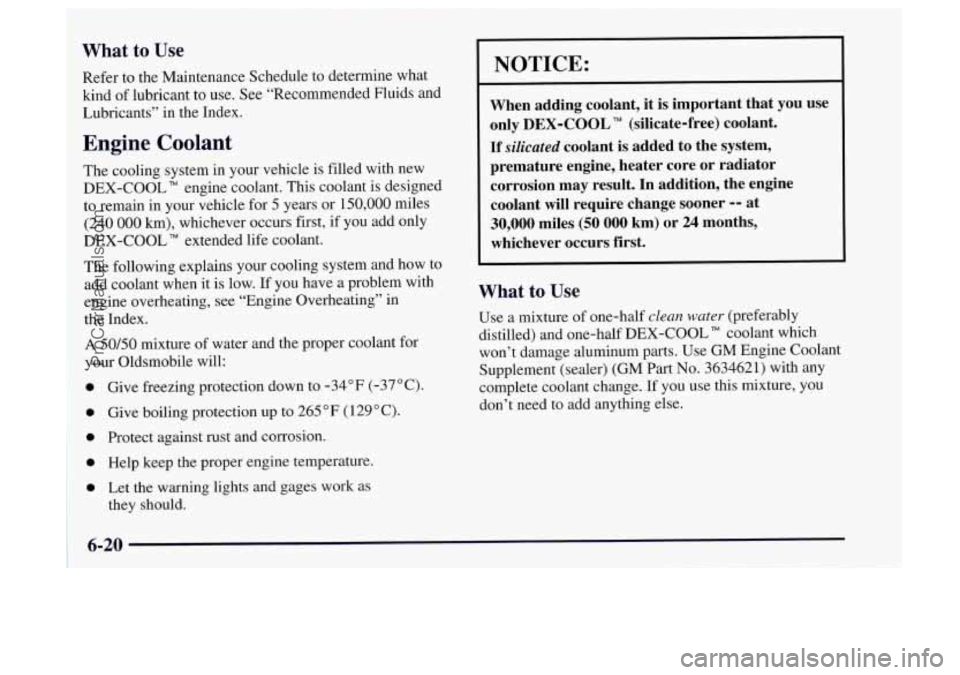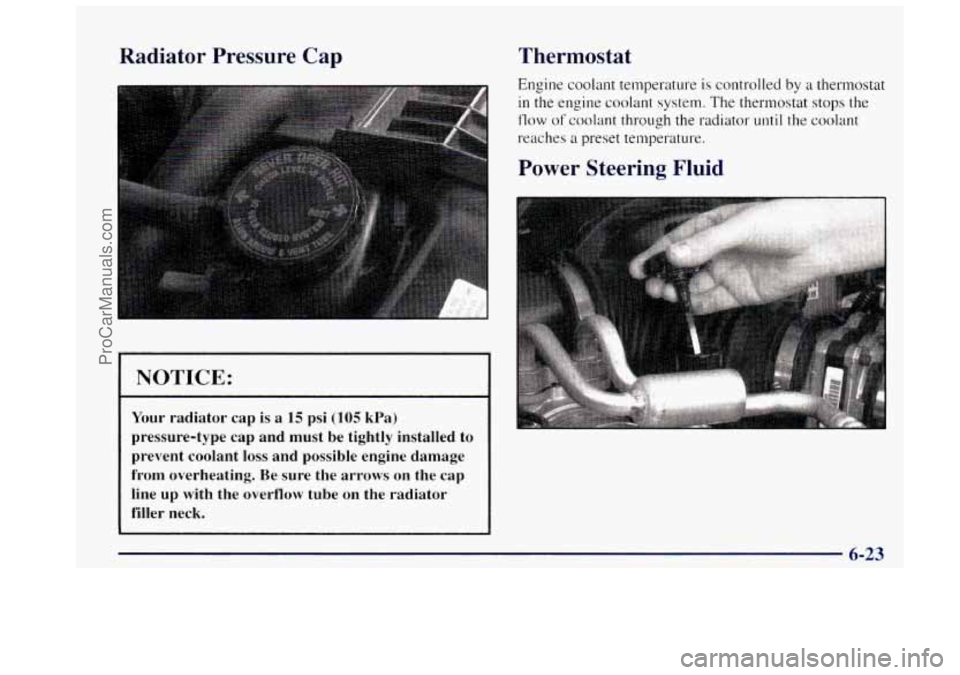1997 OLDSMOBILE BRAVADA coolant temperature
[x] Cancel search: coolant temperaturePage 69 of 358

To Use the Coolant Heater
1. Turn off the engine.
2. Open the hood and unwrap the electrical cord.
3. Plug it into a normal, grounded 1 10-volt AC outlet.
[ON:
-
Plugging the cord into an ungrounded outlet
could cause an electrical shock.
Also, the wrong
kind
of extension cord could overheat and cause
a fire.
You could be seriously injured. Plug the
cord into a properly grounded three-prong
110-volt
AC outlet. If the cord won’t reach, use a
heavy-duty three-prong extension cord rated for
at least
15 amps.
4. Before starting the engine, be sure to unplug and store
the cord as it was before to keep it away fi-om moving
engine
parts. If you don’t, it could be damaged. How
long should you keep the coolant heater plugged
in? The answer depends on the outside temperature, the
kind
of oil you have, and some other things. Instead of
trying to list everything here, we ask that you contact
your Oldsrnobile retailer in the area where you’ll be
parking your vehicle. The retailer can give you the best
advice for that particular area.
Automatic Transmission Operation
P
R
N
03
3
2
1
There are several different
positions for your
shift lever.
PARK (P): This locks your rear wheels. It’s the best
position to use when you start your engine because your
vehicle can’t move easily.
2-15
ProCarManuals.com
Page 110 of 358

Anti-Lock Brake System Warning Light
With the anti-lock brake
system, this light
will come
on when you start your
ANTI - LOCK engine and may stay on for I
If the light stays on, or comes on when you’re driving,
your Oldsmobile needs service.
If the regular brake
system warning light isn’t on, you still have brakes, but
you don’t have anti-lock brakes. If the regular brake
system warning light is also
on, you don’t have anti-lock
brakes and there’s a problem with
your regular brakes.
See “Brake System Warning Light” earlier in
this section.
The anti-lock brake system warning light should come
on briefly when you turn
the ignition key to RUN. If the
light doesn’t corne on then, have
it fixed so it will be
ready to warn you
if there is a problem.
Engine Coolant Temperature Gage
I
This gage shows the engine
coolant temperature.
If the
gage pointer moves into the
red area, your engine
is
too hot!
TEMP
It means that your engine coolant has overheated. If you
have been operating your vehicle under normal driving
conditions, you should pull off the road, stop your
vehicle and turn
off the engine as soon as possible.
In “Problems on the Road,” this manual shows you what
to do. See ”Engine Overheating’‘
in the Index.
2-56
ProCarManuals.com
Page 114 of 358

A reading in the low pressure zone may be caused by a
dangerously low oil level or other problems causing low
oil pressure.
Don’t keep driving if the oil pressure is low. If
you do, your engine can become so hot that it
catches fire. You or others could be burned.
Check your
oil as soon as possible and have yo1
vehicle serviced.
NOTICE:
Damage to your engine from neglected oil
problems can be costly and is not covered by
your warranty.
Daytime Running Lamps Indicator Light
:::(-J 0.0
Check Gages Light
CHECK
GAGES
You may have t.his light on
the instrument panel.
It goes on whenever the
DRL are on, the ignition is
on, the headlamp switch is
off and the parking brake
is released.
The
CHECK GAGES light
will come on briefly when
you are starting the engine.
If the light comes on and
stays on while
you are
driving, check your coolant
temperature and engine oil
pressure gages to see
if they
are
in the warning zones.
2-60
ProCarManuals.com
Page 119 of 358

e
+# HEATER: This setting directs warmed air through
the heater floor outlets and windshield defroster outlets.
we
+# BLEND: Airtlow is divided equally between the
heater floor outlet and the windshield defroster outlets.
%? DEFROST This setting directs most air through
the windshield defroster outlets and some through the
heater outlets.
Air Conditioning
On hot days, open the windows long enough to let hot
inside air escape. This reduces the time
it takes for your
vehicle to cool down. Then keep your windows closed
for the air conditioner to work its best.
For quick cool-down on very hot days, use
MAX A/C
with the temperature knob turned counterclockwise.
This setting should be used to keep odors and/or dust
from entering the vehicle. For normal cooling on hot
days, use A/C with the temperature knob turned
counterclockwise.
On cool but sunny days, use BI-LEVEL A/C to deliver
warm air to the floor and cooler air to the instrument
panel outlets.
When the air conditioner is on,
you may sometimes
notice slight changes
in your vehicle‘s engine speed and
power. This is normal because the system is designed to
cycle the compressor on and off to keep the
desired temperature.
Heating
The heater works best if you keep your windows closed
while using
it. On cold days, use HEATER with the
temperature knob turned clockwise.
BLEND is useful in
cool weather when you have fog or ice on the
windshield or side windows.
If you use the optional engine coolant heater before
starting your engine, your heating system will produce
warmer
air faster to heat the passenger compartment in
cold weather. See “Engine Coolant Heater” in the Tndex.
3-3
ProCarManuals.com
Page 198 of 358

Engine Overheating
’ You will find a coolant temperature gage on your
vehicle’s instrument panel. See “Gages” in the Index.
If Steam Is Coming From Your Engine
Steam from an overheated engine can burn you
badly, even if you just open the hood. Stay away
from the engine
if you see or hear steam coming
from it. Just turn it off and get everyone away
from the vehicle until it cools down. Wait until
there is no sign
of steam or coolant before you
open the hood.
If you keep driving when your engine is
overheated, the liquids in it can catch
fire. You or
others could be badly burned. Stop your engine if
it overheats, and get out of the vehicle until the
engine is cool.
NOTICE:
If your engine catches fire because you keep
driving with
no coolant, your vehicle can be
badly damaged. The costly repairs would not be
covered by your warranty.
5-12
I
ProCarManuals.com
Page 240 of 358

1
; What to Use
I Refer to the Maintenance Schedule to determine what
’ kind of lubricant to use. See “Recommended Fluids and
i Lubricants” in the Index.
1 , I Engine Coolant
; The cooling system in your vehicle is filled with new
1 DEX-COOL” engine coolant. This coolant is designed
I to remain in your vehicle for 5 years or 150,000 miles
I (240 000 km), whichever occurs first, if you add only
~ DEX-COOL” extended life coolant.
I i The following explains your cooling system and how to
i
~
i
add coolant when it is low. If you have a problem with
engine overheating, see “Engine Overheating” in
the Index.
I
A 50/50 mixture of water and the proper coolant for
1 your Oldsmobile will:
’ 0 Give freezing protection down to -34°F (-37°C).
~ 0 Give boiling protection up to 265 “F (129°C). I
~ 0 Protect against rust and corrosion.
0 Help keep the proper engine temperature.
0 Let the warning lights and gages work as
they should.
NOTICE:
When adding coolant, it is important that you use
only
DEX-COOL TM (silicate-free) coolant.
If silicated coolant is added to the system,
premature engine, heater core or radiator
corrosion may result. In addition, the engine
coolant will require change sooner
-- at
30,000 miles (50 000 km) or 24 months,
whichever occurs first.
What to Use
Use a mixture of one-half clean water (preferably
distilled) and one-half DEX-COOL
TM coolant which
won’t damage aluminum parts. Use GM Engine Coolant
Supplement (sealer) (GM Part
No. 3634621) with any
complete coolant change.
If you use this mixture, you
don’t need to add anything else.
ProCarManuals.com
Page 243 of 358

Radiator Pressure Cap Thermostat
Engine coolant temperature is controlled
by a thermostat
in the engine coolant system. The thermostat stops the
flow of coolant through the radiator until the coolant
reaches
a preset temperature.
Power Steering Fluid
NOTICE:
Your radiator cap is a 15 psi (105 kPa)
pressure-type cap and must be tightly installed
to
prevent coolant loss and possible engine damage
from overheating. Be sure the arrows on the cap
line up with the overflow tube on the radiator
filler neck.
6-23
ProCarManuals.com
Page 346 of 358

Electrical Equipment. Adding .................... 6-54
Electrical System
............................... 6-54
Engine
........................................ 6-8
Coolant Heater
............................... 2- 14
Coolant Level Check
.......................... 7-39
Coolant Temperature Gage
..................... 2-56
Exhaust
..................................... 2-22
Identification
................................ 6-53
OilLevelCheck
.............................. 7-39
Overheating
................................. 5-12
Running While Parked
......................... 2-23
Specifications
................................ 6-60
Starting
..................................... 2-13
Engineoil
..................................... 6-9
Additives
................................... 6-12
Kind to Use
................................. 6-10
Pressure Gage
................................ 2-59
Used
....................................... 6-13
Whentochange
.............................. 6-12
Exhaust. Engine
................................ 2-22
Express-Down Window
.......................... 2-24
Exterior Metal Parts. Protecting
.................... 6-49
Fabric cleaning
............................... 6-45
FillingYourTank
................................ 6-5
Filter.
Air ..................................... 6-13
Finish Care
.................................... 6-49 Finish
Damage
.................................
Flat Tire. Changing ............................. 5-21
Fluids and Lubricants
....................... 6-61. 7-45
Fog Lamp Switch
............................... 2-33
Foreign Countries. Fuel
........................... 6-4
Front Axle
....................................... 6-18
Reading Lamp Bulb Replacement
................ 6-33
Towing
..................................... 5-10
Turn Signal Lamp Bulb Replacement
............. 6-31
Fuel
.......................................... 6-3
Filling Your Tank
.............................. 6-5
Foreign Countries
.............................. 6-4
Gage
....................................... 2-61
Fuses and Circuit Breakers
....................... 6-55
Flashers.
Hazard Wdrning
......................... 5-2
Storage Area
................................. 2-39
Gages
Engine Coolant Temperature .................... 2-56
Engine Oil Pressure
........................... 2-59
Fuel
....................................... 2-61
Garage Door Opener
............................ 2-44
GasCap
....................................... 6-5
Gear Positions
................................. 2-15
GAWR ....................................... 4-42
ProCarManuals.com